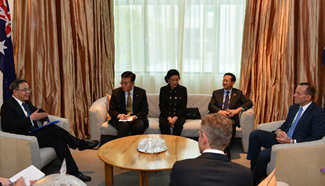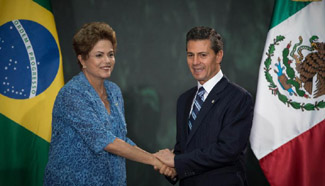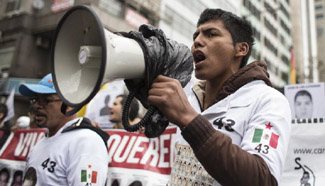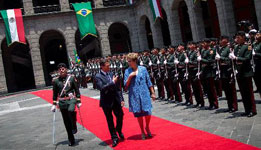
????In the sky, helicopters attacked the field along with paratroops in parafoils and parachutes; on the ground, commandos in special vehicles secretly moved towards the “enemy”. The Sharp Knife Airborne-2014 joint anti-terrorism exercise conducted by paratroopers from the Chinese and Indonesian air forces concluded on Nov. 3. It coincided with the 65th anniversary of the founding of the Chinese People’s Liberation Army Air Force (PLAAF). It also reflected in microcosm the Chinese air force’s exchanges and cooperation with foreign counterparts in recent years. PLAAF spokesman Colonel Shen Jinke said the air force was taking a more open, confident and pragmatic attitude to expand the range and areas of cooperation with foreign counterparts and enhance the ability to conduct operations in a broader area, so as to make a positive contribution towards peace and development.
????Joint exercise and training
????Sharp Knife Airborne-2014 and the Peace Mission-2014 exercise show the PLAAF has been deepening exchanges and cooperation with foreign air forces, said Shen.
????In the Peace Mission-2014 joint anti-terrorism exercise, unmanned aerial vehicles integrating surveillance and strike capabilities made their debut, airborne troops carried out landing operations with their equipment, and fighter jets conducted precision strikes. At the Zhurihe training base in north China’s Inner Mongolia Autonomous Region, the Chinese, Kazakhstan and Russian air forces conducted joint command and operations in an information-led mission, involving precision and asymmetric operations.
????In recent years, the Peace Mission joint anti-terrorism exercises have become a fixture for the air force. In 2010, Chinese fighter jets hit all their targets in 48 strikes. In 2013, Chinese “Flying Leopard” fighters flew more than 6,000 kilometers to join Russian counterparts in Chelyabinskaya. The 2014 exercise was the biggest yet for the Chinese air force in terms of personnel and equipment.
????In the past five years, the Chinese air force has conducted 13 joint exercises and training operations with foreign air forces. In March 2011, it conducted a joint exercise with the Pakistan air force in Pakistan codenamed Falcon-I. In September 2013, Falcon-II was held in Xinjiang, the first time the Chinese air force had trained with a foreign air force in China. In July 2014, the Chinese air force sent a detachment to the Aviadarts-2014 international pilot competition in Russia to promote communication with foreign air forces.
????An important combat section of China’s air force, the airborne force uses training methods in line with international practice to showcase their openness.
????In July 2011, airborne troops of China and Belarus conducted a joint anti-terrorism exercise codenamed Condor-2011 in Belarus. During the ten-day event, paratroopers from both sides completed their tasks successfully. As well as being the first joint drill by Chinese and Belarusian armed forces, it was also the first time Chinese paratroopers had trained abroad with foreign soldiers.
????Now China’s airborne troops have training partners in Asia, Europe and the Americas. In November 2011, Chinese and Venezuelan airborne troops conducted a joint exercise in Venezuela. In 2012, Chinese and Belarusian airborne troops held the Falcon-2012 joint anti-terrorism exercise in China. It was the first time Chinese paratroops had trained with foreign counterparts in China. In November 2013, Chinese paratroopers trained with Indonesian counterparts for the first time in the Sharp Knife Airborne-2013 joint anti-terrorism exercise in Bandung.
????A Chinese airborne special commando unit named “Thor” has developed as a new “light, flexible and multi-purpose” force since its launch three years ago. In the Falcon-2012 joint exercise, the “Thor” commandoes parachuted in low visibility, winning praise from Belarusian counterparts.
????Joint training and exercises have had a great and lasting impact on China’s air force and all personnel have learned much from them.










